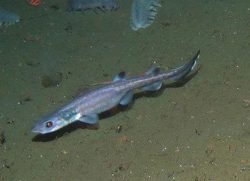select your film:


Filetail Catsharks are small, soft bodied deepwater sharks that live between 88 to 1250 m deep in the Eastern Pacific Ocean.
Biology and Behaviour
Filetail catsharks are slender and grey-brown in colour with lobed fins that are set further back on their body. They have a short snout and broad, triangular nasal flaps. Their two dorsal fins are relatively the same size. The first dorsal fin begins just after the origin of the pelvic fin, and the second dorsal fin – smaller than the anal fin – is almost over the origin of the anal fin.
Their body has adapted to the deepwater environment. Filetail catsharks have large, oval-shaped eyes because of the darkness of the deepwater and they have larger gills for the lower oxygen levels underwater.
Adult filetail catsharks are commonly found near rocky vertical relief over soft mud bottoms. They feed on a variety of small fish and invertebrates.
Reproduction and Lifespan
Filetail catsharks are oviparous and females lay eggs in pairs. Eggs are laid throughout the year, mostly from July to September, which indicates that filetail catsharks have high fecundity, but gestation period can reach up to 24 months. Hatchlings are seven to nine cm long at birth. Males mature between 37.5 to 45 cm long, while females mature between 42.5 to 50 cm in length. They can grow up to 60 cm long.
Conservation and Tourism
The IUCN lists filetail catsharks as least concern, and there are no species-specific conservation methods in place.
Do you have images or videos of Filetail Catsharks?
Submit them to [email protected].
